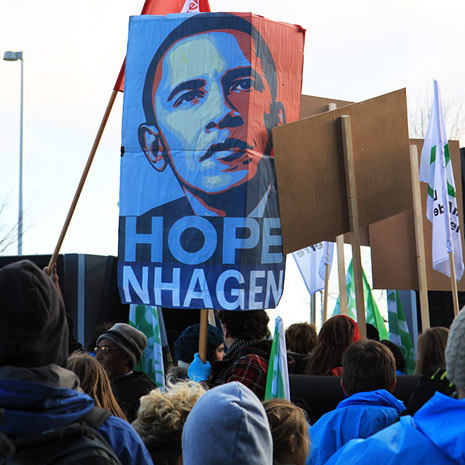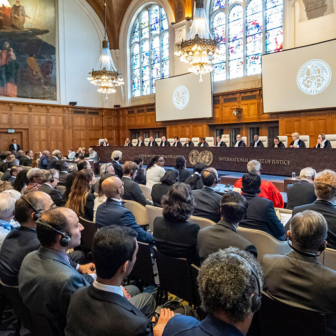LIVING as we do at a time when arguments about climate change are being turned on their heads – my favourite recent example being the creed of a Tea Party group in Ohio: “The regulation of Carbon Dioxide in our atmosphere should be left to God and not government and I oppose all measures of Cap and Trade as well as the teaching of global warming theory in our schools” – you might think the title of this article constitutes a novel version of climate denial. Surely last year’s UN climate conference in Copenhagen was a monumental failure that set back action to curb carbon emissions for years?
Well yes, in terms of its core ambition Copenhagen was indeed a failure. It failed to achieve a legally binding global treaty to cut emissions enough to limit global warming to 2°C above pre-industrial levels. Indeed, it failed to achieve a UN-endorsed agreement at all, and ended in a welter of chaos and acrimony that has still not fully subsided.
But looked at another way Copenhagen didn’t fail, and it hasn’t stopped action aimed at combating climate change. As a result of Copenhagen every major economy in the world has now made commitments to reduce emissions, and most are beginning to implement them. So far from global action being retarded, there are signs that it is now accelerating, and that Copenhagen is part of the cause.
It’s worth understanding this, because the next UN climate conference begins in Cancun, Mexico, later this month, and may well conclude without reaching any substantive agreement, even of the limited kind that is the most anyone now hopes for. In that event the cry will inevitably go up that two successive failed conferences demonstrate the impossibility of global action on climate. But it won’t be true; on the contrary, it is the simultaneous failure and success of Copenhagen that holds the key to understanding how future progress can be made.
So let’s go back and recall what did and did not happen in the freezing Danish capital last December, trying to untangle the reality from the many myths that have grown like ivy around it. (As one of those involved in the final negotiations, I can remember the traumatic events only too well; many of us dreamed about them for weeks afterwards – though they never turned out any better that way.)
First, it isn’t true to say that nothing was achieved in Copenhagen. The Copenhagen Accord, the agreement negotiated by a representative group of thirty heads of government on the penultimate day of the conference, was the first agreement endorsing the 2°C limit, and the first under which developing as well as developed countries committed to a significant slowing in their own emissions. It includes almost US$30 billion in funding for the poorest countries between 2010 and 2012, with a goal of $100 billion per annum in finance for those countries by 2020.
In itself the Copenhagen Accord is a thin document, no more than an outline text of a proper agreement. And of course it wasn’t endorsed by the conference as a whole, meaning that it does not have the status of a formal UN decision. That lack of endorsement – and the blank pages at the back where countries’ emissions targets were meant to be – understandably left observers last December claiming it was a damp squib.
But the picture is rather different today. In the months since the conference over 130 countries – two-thirds of the UN membership – have signed up to the Copenhagen Accord, and over eighty, representing over 80 per cent of global emissions, have entered emissions reduction commitments into its annexes. If implemented in full, these commitments will see global emissions peak before 2020, an achievement that is the essential foundation of any move towards the stabilisation of greenhouse gases. They are not enough to ensure the 2°C goal – together they amount to emissions cuts of 12 to 19 per cent on 1990 levels, compared to the minimum target of 25 per cent proposed by the Intergovernmental Panel on Climate Change – but they are far from insignificant. Not only do the annexes of the Copenhagen Accord represent the first set of properly global emissions reduction commitments ever made, some of them are also extremely far-reaching.
Indeed, the extraordinary thing about these commitments is that by far the largest reductions relative to existing trends are being pledged by the developing rather than developed countries. With an annual growth rate of 9 to 10 per cent, China’s commitment to improve the carbon intensity of its economy by 40 to 45 per cent by 2020 (or even to exceed this, as Premier Wen Jiabao noted in Copenhagen) will involve huge investments in energy efficiency and low-carbon fuels. Brazil’s target of a reduction of 36 to 39 per cent in emissions over its currently projected trends will require a quantum reduction in deforestation rates in the Amazon. Indonesia has made similar commitments to protect its forests; India has embarked on a huge expansion of solar power; South Korea has adopted the largest “green stimulus” package of any country in the world. Of developed countries, only Japan, with a commitment to cut emissions by 25 per cent by 2020 on 1990 levels, stands comparison.
It is these commitments that were the real achievement of Copenhagen. Not achievements of the negotiations – they were all announced before the conference even began – but of the fact of the conference itself. For there is no question that few countries would have made these commitments, and they would certainly not have made them as ambitious, if it hadn’t been for the pressure of the approaching summit. One of the criticisms made of Copenhagen was that it shouldn’t have been hyped up so much by the politicians; it was the heightened expectations, it is said – including the conversion of the event into a leaders’ summit, which it was never originally meant to be – that made the subsequent failure so much worse. But this is to ignore the fact that it was precisely those expectations, and the intense media and diplomatic pressure that accompanied them, that forced every major economy into making emissions reduction commitments in the run up to the event. Most of the developing countries had been denying up to that point that they had any obligation to adopt targets at all.
And the really crucial thing about the commitments is that they were domestic, not . They were made not as part of a deal with other countries, but as responses to domestic political pressures. In turn, this makes them much more likely to be implemented, because governments will be held accountable not by the nebulous forces of diplomacy but by the intense scrutiny of their media and political parties at home. Witness, for example, how Brazil’s Copenhagen commitments featured in its recent presidential election campaign, in which a charismatic environmentalist was one of the three candidates and won an unexpectedly large share of the vote. Watch the seriousness with which China’s twelfth Five Year Plan, the outline of which was published last week, will implement its Accord targets.
So this is why Copenhagen cannot be regarded as a (complete) failure. It is because of Copenhagen that the world is now beginning to embark on the first serious attempt in its history to bend the otherwise inexorable curve of rising emissions.
There is no question, of course, that the inability to achieve a legally binding treaty was a huge disappointment. Yet this was not really a failure of Copenhagen. For another truth that’s been much obscured is that the ideal of a legally binding treaty had become impossible long before the conference began. By the time Copenhagen got under way it was evident to all but the most blinkered observers – and the Danish government had made it abundantly clear in setting out the goals of the summit – that, while a treaty was still the ultimate goal, the most the conference itself could achieve was a political agreement signed by the leaders, incorporating the substance of a treaty but not its final legal form.
The ostensible reason for this reduced ambition was that the negotiators had run out of time to turn their lengthy and far-from-agreed negotiating texts into a legally watertight treaty. But in reality the reason was that it had become clear that the kinds of treaty to which the major countries were prepared to commit were very different, and simply too far apart to allow agreement.
For the developing countries the required post-2012 treaty already existed: it was the Kyoto Protocol. This required developed countries to take on legally binding emissions caps and developing countries to make entirely voluntary efforts of their own choosing. But signing up to Kyoto was out of the question for the United States, whose Senate had rejected it without a single vote in support the first time round. And no developed country, including the main Kyoto signatories – the European Union, Japan, Australia, Russia and Canada – regarded it as acceptable that they should continue to make legally binding commitments while the newly emerging economies, whose emissions were now rising fastest, were not legally bound to do anything at all.
In the end it was this fundamental divergence of view on the nature of a treaty – whether or not the developing countries were to be legally bound to take their actions in the same way that developed countries were legally bound by their emissions caps – which made achieving such an agreement in Copenhagen impossible. And this remains the case, which is why a treaty is no more likely this year or next than it was last.
The United States, of course, is in no political position to agree to a treaty even if the developing countries were prepared to. Following the collapse of the Senate energy and climate legislation in July, the United States is now one of the only countries that has no plans to implement its Copenhagen Accord commitments (a 4 per cent reduction on 1990 levels by 2020). It is let off the hook only because China and India are also unwilling to adopt legally binding targets at this time.
China’s position is particularly instructive. It is not that China is unwilling to adopt targets: it has entered its domestic targets into the Accord. It’s just that it is not prepared to be bound to these by treaty until it is sure that they can be achieved. This was why China famously removed from the Copenhagen Accord not just the goal of a 50 per cent cut in global emissions by 2050, but also the developed countries’ commitment to an at least 80 per cent cut in their own emissions in the same period. China’s reasoning is that if the developed countries cut by 80 per cent, and total emissions are cut by 50 per cent, that leaves only a defined volume of “carbon space” left in the atmosphere for its own development. And at this stage it really doesn’t know if it can achieve the economic growth and prosperity it wants within this space. And if it doesn’t know, it is not willing to be legally bound.
So if this is what Copenhagen achieved, but also why it failed, what are the lessons we should draw for climate change action today?
First, there is no prospect of achieving a top-down agreement – one whose principal goals are determined by negotiation, and which countries subsequently decide how they are going to implement at home. An agreement has to be bottom up: the sum of commitments made domestically in each of the major economies, not their cause. Second, and following that, it is at national and sub-national level that climate action will mainly take place over the next few years. The negotiations at the United Nations can at best merely supplement this.
Third, we need stronger commitments. Those made in the run-up to Copenhagen and entered into the annexes of the Accord are good, but they do not ensure a 2°C world. Sometime in mid-decade, if not before, these commitments will need to be ramped up, perhaps with additional targets for 2030 en route to 2050. And last, we shall almost certainly need a moment at which leaders are required once again to come together and make commitments, as they were in Copenhagen, if such a strengthening is to occur. We will need another hyped-up climate change summit on which NGOs, businesses, countries and others can target their campaigns: only this will force governments into stronger action.
So if the Cancun conference this month fails, don’t despair. It doesn’t mean action on climate change has stalled. The real progress on curbing emissions growth is occurring not in the negotiations but in domestic policy, in the major emerging economies and elsewhere. We will need a treaty at some time in the future to bring all this together and make it stronger, but it’s not likely to happen in the next three years, and certainly not before the next US presidential election. In the meantime, we can look back on the Copenhagen conference a year ago and say, with justification, that it wasn’t in fact as disastrous as has generally been assumed. On the contrary: it might actually prove to have been the turning point. •




